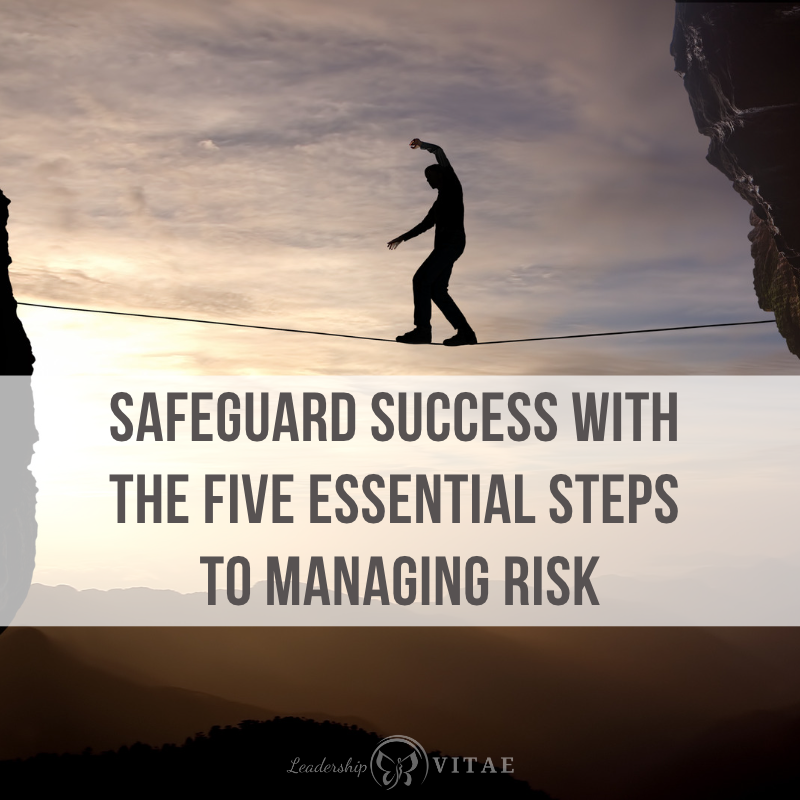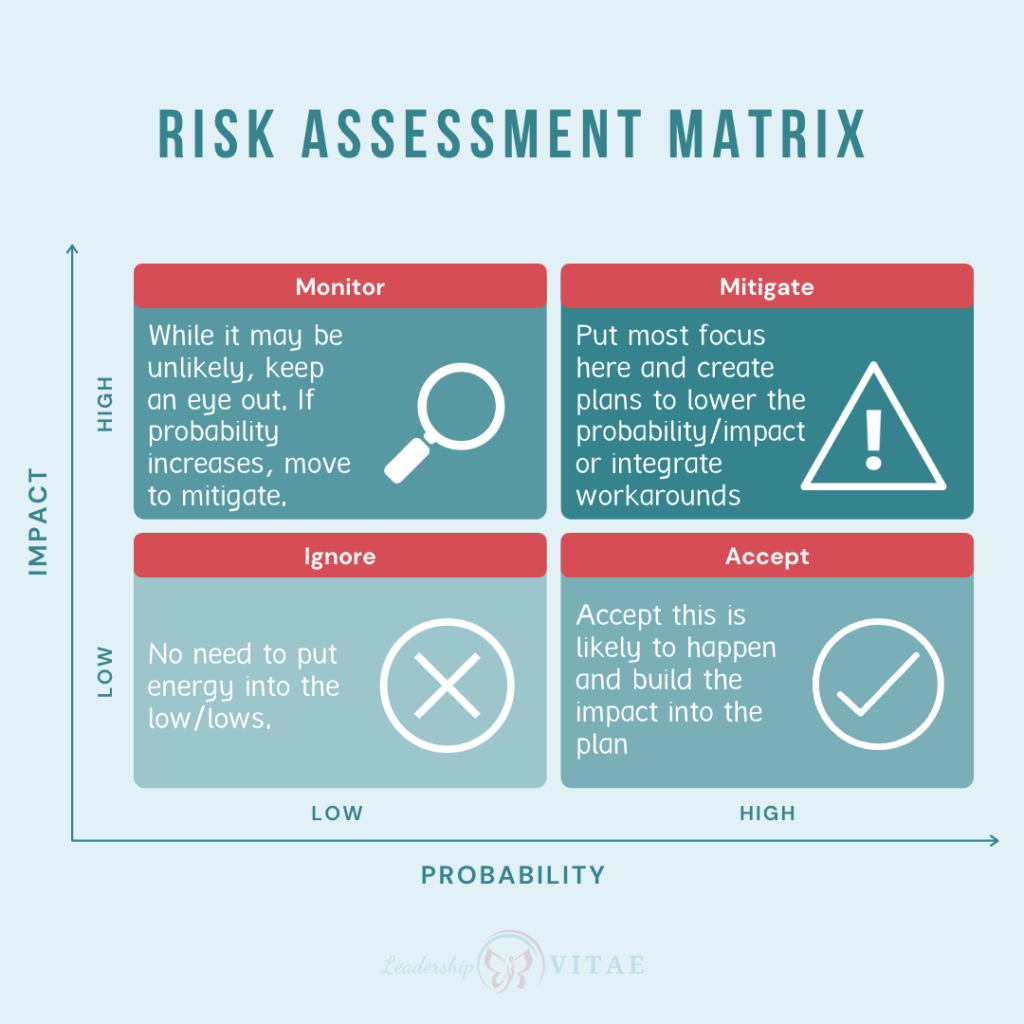
Transformation work involves creating something new and different. Whether we are starting from scratch or affecting change to something existing, it’s a journey with twists and turns to get to an imagined endpoint.
To get there, we’re going to encounter risk…both the good kind (the unexpected win) and the bad kind (holy crap that came out of nowhere). If we’re leading the charge, our ability to manage risk is key to navigating the journey effectively to the outcome we desire.
I have a new role, returning to transformation work. As part of that change, I am sharing some of the considerations and approaches I’ll be taking with me. This is the final article in a three-part series to help others who may be asked to lead transformations.
There is no change without risk (or everyone would be doing it). We don’t have to like it, but the reality is that we will find ourselves at forks in the road on our transformation journey. Each fork represents a risk and the path we choose to take. How we manage that risk can make the difference between taking the path to resounding success or abysmal failure.
Measuring risk
In project management, we’re taught that one of the first steps is to measure risk. While that holds, the method recommended to measure it is incomplete.
Traditional models measure Risk = Probability * Impact. If we think of it on a 2×2 grid, it might look something like this:

While this can be a fine model to determine where to focus on risk mitigation for the average project, transformation efforts need another lens. We need to consider perception.
After years of doing this kind of work, I can feel as though I’m on solid footing while others perceive I’m hanging by my fingertips off the edge of a cliff. Depending on who has this perception, it can hinder progress.
Risk goes beyond probability and impact. The new formula is (ProbabilityP1 * ImpactP1) + (ProbabilityPn * ImpactPn).
If we consider the various players in our transformation effort, such as key stakeholders, team members, partners, and ourselves, we each have our own perception of risk. If we collect the perceived probability and impact from each of these individuals, we can compare relative risk.
| Risk 1 | Risk 2 | Risk 3 | |
| Stakeholder Perspective | High I / Low P | High I / High P | Low I / Low P |
| Team Member Perspective | Low I / Low P | High I / Low P | Low I / High P |
| Transformation Leader Perspective | Low I / High P | High I / Low P | Low I / Low P |
In each of these cases, it’s worth having a conversation with stakeholders or team members. If they consider impact or probability differently than other roles, understanding why may influence how others perceive the overall risk. It’s only with these disparate views that a better sense of the real risk can be developed.
Build trust
From the first interactions with our teams, peers, and stakeholders, we are either building or eroding trust. It’s the glue that binds transformation efforts together. Whether it’s the connection between team members, stakeholders, or customers…without trust, getting anything done will be an uphill battle.
We build trust by making commitments and delivering on them. Doing the things we say we will do. Considering and integrating others’ viewpoints, or providing context as to why one path may be better than another.
Building relationships based on trust creates equity we will likely need as challenges occur. Whether it’s a risk realized or an opportunity we want to pursue, trust is our currency.
Years ago, a stakeholder commented that he’d say yes to anything I asked because he knew I’d only come to him if it was necessary. I shared risks in terms of probability and impact, based on my perception and those around me. I’d ask him to make the call, since it was his business unit and his perception that mattered most. With trust as a foundation, I was able to get the support I needed when – inevitably – change was hard.
Start building trust early, before risks are realized. It becomes the bank of relationship capital needed when things go sideways and we need help or support.
Embrace positive risk
Too often we think of risk as a negative. There are some risks, however, that may have a positive impact if we can take advantage of them. They are the risks that might accelerate delivery, reduce cost, or otherwise ensure we achieve the value and timeframes we aspire to.
When we identify and integrate positive risk into our efforts, it creates room for the unanticipated. They may not look positive at the outset, such as changing direction or shifting vendors. But if they save time and money, they are positive risks.
There was one such opportunity on a project I led a few years ago. We changed direction to create capacity for other more common risks, such as underestimating the time it would take to finish our software development. When those risks didn’t manifest, we delivered a year early and significantly under budget.
If we only look for the negative, that’s what we’ll find. Training ourselves to look for opportunities may take some time and effort, but then we’re more likely to find them.
Communicate transparently
This will show up in every leadership framework and model I develop. For a reason.
There is no more important tool in transformation efforts than communication. When it’s done poorly, even the most organized and planned project will fail. When done well, minor stumbles don’t become major catastrophes.
How do we communicate well? By understanding what types of information matters when to those we lead and support. First, we consider all the various populations that come together to make our transformation effort a success. Then we ask – what do you need to know from me?
Do our stakeholders have regular updates they have to provide? If so, what do they need from us to ensure the information shared is timely and relevant?
For our team members…what would they like to know with what frequency to feel engaged and empowered?
With this input, we can build a communication plan that accounts for the needs of our various audiences. Keeps that trust we’ve built strong. When we keep folks in the know, they are primed if we need help, have a risk we need to mitigate, or have to change course.
Adapt and overcome
We took the time to assess known risks, built trust with key players, look out for the good stuff so we have room for the bad, and communicated to those that needed to stay informed. Even if we’ve done all those things, there’s one more step to consider.
How to adapt and overcome. No matter how much we may be prepared for risks, a plan is only as good as the day we built it. As soon as the next day starts, new issues can arise. Our ability to adjust course as new information comes to light makes the difference between success and staying the course off an avoidable cliff.
If we are committed to our plan, we are committed to a path that may not lead to the outcomes we want. We are living in a time of disruption and constant change. While our job is to affect change, we aren’t doing that in a stable environment. Instead, we are navigating twists and turns on a spinning platform.
This is why trust and communication are so critical. We need more eyes than just our own looking at what’s happening. Others able to perceive potential risks and opportunities so we can dodge and weave in a way that affects the best outcomes.
Those around us are more likely to share what they are seeing when they know we’ll adjust in response. If we are responsible for change, then we too have to be willing to change. Our minds and our course…or that outcome we desire will remain elusive.
* * *
What else would you recommend to effectively manage risk when navigating change? Please share your thoughts in the comments below to help others on the transformation leadership journey.








